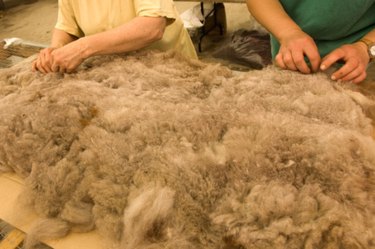
Staying warm against the winter cold does not have to be a struggle. Dressing yourself in clothing made from the right materials makes all the difference. Winter clothing should be made from fabrics with high insulation properties, meaning the heat stays in and the cold stays out.
Wool
Video of the Day
The use of wool is thought to date back at least 30,000 years, and it continues to be a popular choice today. Wool is extremely effective because it retains its insulation properties even when wet. Wool also absorbs moisture from the body, allowing you to stay warm and dry. The caveat of wool is that it tends to be itchy or uncomfortable. Wool also becomes extremely heavy and prone to misshaping and breakage when wet.
Video of the Day
Polyester Fleece
"Polar fleece" was first introduced by Maiden Mills in the early 1980s. Fleece is a lightweight fabric made from polyethylene fibers. It is softer and more water-resistant than wool. Like wool, it has the ability to insulate the body even when wet. However, fleece is not wind-resistant and is best used in a layered design.
Down
Made from the soft undercoating of ducks and geese, down is a popular material for blankets and outdoor clothing. With proper maintenance, down articles can last for a long time. It is also prized for being lightweight and highly compressible, an advantage for storage or travel. There are a few disadvantages to down, however. It is not water-resistant at all and takes a long time to dry. Down is also expensive and garments are difficult to clean. Some people may experience allergies to down as well.
Outer Materials
Some materials make great insulators, but are uncomfortable if worn directly next to the skin. A polyester, waterproof lining is often used with down or fiberfill coats. Mohair and fur are good protectors against wind and bitter cold. Synthetic versions of mohair and fur are common for those with allergies or moral reservations.